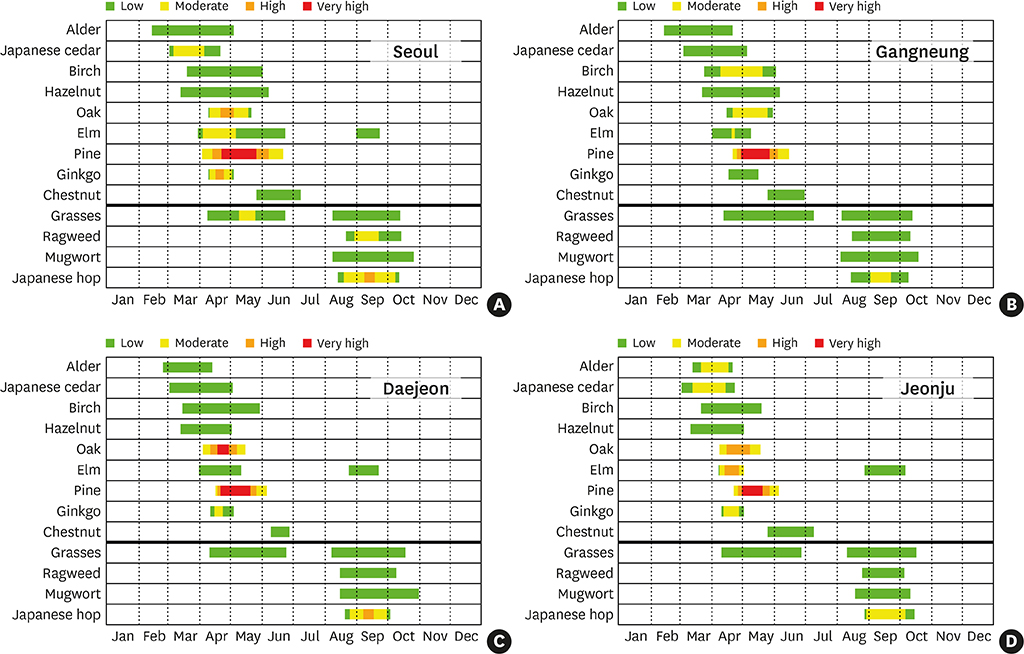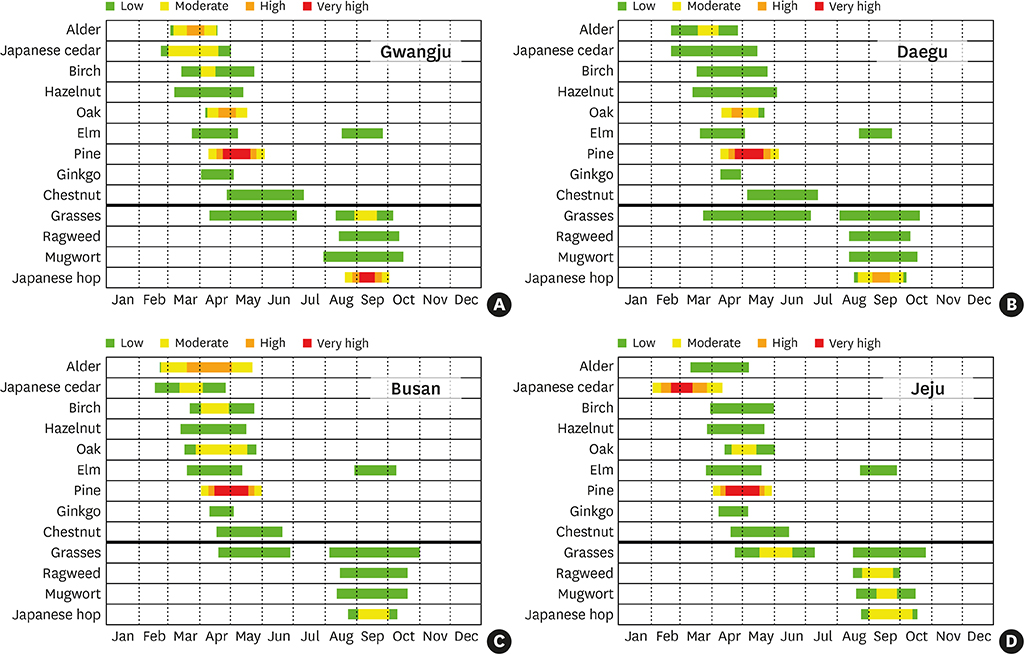Allergy Asthma Immunol Res.
2020 Mar;12(2):259-273. 10.4168/aair.2020.12.2.259.
Allergenic Pollen Calendar in Korea Based on Probability Distribution Models and Up-to-Date Observations
- Affiliations
-
- 1Applied Meteorology Research Division, National Institute of Meteorological Sciences, Seogwipo, Korea. krk9@kma.go.kr
- 2Department of Pediatrics, Hanyang University Guri Hospital, Hanyang University College of Medicine, Seoul, Korea. jaewonoh@hanyang.ac.kr
- KMID: 2468461
- DOI: http://doi.org/10.4168/aair.2020.12.2.259
Abstract
- PURPOSE
The pollen calendar is the simplest forecasting method for pollen concentrations. As pollen concentrations are liable to seasonal variations due to alterations in climate and land-use, it is necessary to update the pollen calendar using recent data. To attenuate the impact of considerable temporal and spatial variability in pollen concentrations on the pollen calendar, it is essential to employ a new methodology for its creation.
METHODS
A pollen calendar was produced in Korea using data from recent observations, and a new method for creating the calendar was proposed, considering both risk levels and temporal resolution of pollen concentrations. A probability distribution was used for smoothing concentrations and determining risk levels. Airborne pollen grains were collected between 2007 and 2017 at 8 stations; 13 allergenic pollens, including those of alder, Japanese cedar, birch, hazelnut, oak, elm, pine, ginkgo, chestnut, grasses, ragweed, mugwort and Japanese hop, were identified from the collected grains.
RESULTS
The concentrations of each pollen depend on locations and seasons due to large variability in species distribution and their environmental condition. In the descending order of concentration, pine, oak and Japanese hop pollens were found to be the most common in Korea. The pollen concentrations were high in spring and autumn, and those of oak and Japanese hop were probably the most common cause of allergy symptoms in spring and autumn, respectively. High Japanese cedar pollen counts were observed in Jeju, while moderate concentrations were in Jeonju, Gwangju and Busan.
CONCLUSIONS
A new methodology for the creation of a pollen calendar was developed to attenuate the impact of large temporal and spatial variability in pollen concentrations. This revised calendar should be available to the public and allergic patients to prevent aggravation of pollen allergy.
Keyword
MeSH Terms
Figure
Cited by 1 articles
-
Revised Pollen Calendar in Korea
Jung-Won Park
Allergy Asthma Immunol Res. 2020;12(2):171-172. doi: 10.4168/aair.2020.12.2.171.
Reference
-
1. Jariwala SP, Kurada S, Moday H, Thanjan A, Bastone L, Khananashvili M, et al. Association between tree pollen counts and asthma ED visits in a high-density urban center. J Asthma. 2011; 48:442–448.
Article2. Darrow LA, Hess J, Rogers CA, Tolbert PE, Klein M, Sarnat SE. Ambient pollen concentrations and emergency department visits for asthma and wheeze. J Allergy Clin Immunol. 2012; 130:630–638.e4.
Article3. Ito K, Weinberger KR, Robinson GS, Sheffield PE, Lall R, Mathes R, et al. The associations between daily spring pollen counts, over-the-counter allergy medication sales, and asthma syndrome emergency department visits in New York City, 2002–2012. Environ Health. 2015; 14:71.
Article4. Emberlin J, Mullins J, Corden J, Jones S, Millington W, Brooke M, et al. Regional variations in grass pollen seasons in the UK, long-term trends and forecast models. Clin Exp Allergy. 1999; 29:347–356.
Article5. Recio M, Trigo MM, Docampo S, Melgar M, García-Sánchez J, Bootello L, et al. Analysis of the predicting variables for daily and weekly fluctuations of two airborne fungal spores: Alternaria and Cladosporium. Int J Biometeorol. 2012; 56:983–991.6. Sabariego S, Cuesta P, Fernández-González F, Pérez-Badia R. Models for forecasting airborne Cupressaceae pollen levels in central Spain. Int J Biometeorol. 2012; 56:253–258.
Article7. Kim KR, Kim M, Choe HS, Han MJ, Lee HR, Oh JW, et al. A biology-driven receptor model for daily pollen allergy risk in Korea based on Weibull probability density function. Int J Biometeorol. 2017; 61:259–272.
Article8. Park KJ, Kim HA, Kim KR, Oh JW, Lee SY, Choi YJ. Characteristics of regional distribution of pollen concentration in Korean Peninsula. Korean J Agric For Meteorol. 2008; 10:167–176.
Article9. Oh JW, Lee HB, Kang IJ, Kim SW, Park KS, Kook MH, et al. The revised edition of Korean calendar for allergenic pollens. Allergy Asthma Immunol Res. 2012; 4:5–11.
Article10. Hauser M, Asam C, Himly M, Palazzo P, Voltolini S, Montanari C, et al. Bet v 1-like pollen allergens of multiple Fagales species can sensitize atopic individuals. Clin Exp Allergy. 2011; 41:1804–1814.
Article11. Bousquet J, Cour P, Guerin B, Michel FB. Allergy in the Mediterranean area. I. pollen counts and pollinosis of Montpellier. Clin Allergy. 1984; 14:249–258.
Article12. Freeman GL. Pine pollen allergy in northern Arizona. Ann Allergy. 1993; 70:491–494.13. Schenk S, Breiteneder H, Susani M, Najafian N, Laffer S, Duchêne M, et al. T cell epitopes of Phl p 1, major pollen allergen of timothy grass (Phleum pratense). In : Sehon A, HayGlass KT, Kraft D, editors. New horizons in allergy immunotherapy. Boston (MA): Springer US;1996. p. 141–146.14. Hiller KM, Esch RE, Klapper DG. Mapping of an allergenically important determinant of grass group I allergens. J Allergy Clin Immunol. 1997; 100:335–340.
Article15. Grobe K, Becker WM, Schlaak M, Petersen A. Grass group I allergens (β-expansins) are novel, papain-related proteinases. Eur J Biochem. 1999; 263:33–40.16. Duffort O, Quintana J, Ipsen H, Barber D, Polo F. Antigenic similarity among group 1 allergens from grasses and quantitation ELISA using monoclonal antibodies to Phl p 1. Int Arch Allergy Immunol. 2008; 145:283–290.
Article17. Bruce CA, Norman PS, Rosenthal RR, Lichtenstein LM. The role of ragweed pollen in autumnal asthma. J Allergy Clin Immunol. 1977; 59:449–459.
Article18. Popa VT. Respiratory allergy to ragweed: correlation of bronchial responses to allergen with bronchial responses to histamine and circulating immunoglobulin E. J Allergy Clin Immunol. 1980; 65:389–397.
Article19. Rosenberg GL, Rosenthal RR, Norman PS. Inhalation challenge with ragweed pollen in ragweed-sensitive asthmatics. J Allergy Clin Immunol. 1983; 71:302–310.
Article20. Pollart SM, Chapman MD, Fiocco GP, Rose G, Platts-Mills TA. Epidemiology of acute asthma: IgE antibodies to common inhalant allergens as a risk factor for emergency room visits. J Allergy Clin Immunol. 1989; 83:875–882.
Article21. Park HS, Kim MJ, Moon HB. Antigenic relationship between mugwort and ragweed pollens by crossed immunoelectrophoresis. J Korean Med Sci. 1994; 9:213–217.
Article22. Kim JH, Oh JW, Lee HB, Kim SW, Kang IJ, Kook MH, et al. Changes in sensitization rate to weed allergens in children with increased weeds pollen counts in Seoul metropolitan area. J Korean Med Sci. 2012; 27:350–355.
Article23. Park HS, Nahm DH, Suh CH, Lee SM, Choi SY, Jung KS, et al. Evidence of Hop Japanese pollinosis in Korea: IgE sensitization and identification of allergenic components. J Allergy Clin Immunol. 1997; 100:475–479.
Article24. Choi IS, Lee SS, Myeong E, Lee JW, Kim WJ, Jin J. Seasonal variation in skin sensitivity to aeroallergens. Allergy Asthma Immunol Res. 2013; 5:301–308.
Article25. Kim JH, Oh JW, Lee HB, Kim SW, Chung HL, Kook MH, et al. Evaluation of the association of vegetation of allergenic plants and pollinosis with meteorological changes. Allergy Asthma Respir Dis. 2014; 2:48–58.
Article26. So HJ, Moon SJ, Hwang SY, Kim JH, Jang HJ, Jo JH, et al. Characteristics of airborne pollen in Incheon and Seoul (2015–2016). Asia Pac Allergy. 2017; 7:138–147.
Article27. Ruiz-Valenzuela L, Aguilera F. Trends in airborne pollen and pollen-season-related features of anemophilous species in Jaen (south Spain): a 23-year perspective. Atmos Environ (1994). 2018; 180:234–243.
Article28. Šikoparija B, Marko O, Panić M, Jakovetić D, Radišić P. How to prepare a pollen calendar for forecasting daily pollen concentrations of Ambrosia, Betula and Poaceae? Aerobiologia (Bologna). 2018; 34:203–217.
Article29. Weinberger KR, Kinney PL, Lovasi GS. A review of spatial variation of allergenic tree pollen within cities. Arboric Urban For. 2015; 41:57–68.30. Jato V, Rodríguez-Rajo FJ, Alcázar P, De Nuntiis P, Galán C, Mandrioli P. May the definition of pollen season influence aerobiological results? Aerobiologia (Bologna). 2006; 22:13–25.
Article31. American Academy of Allergy Asthma & Immunology. National allergy bureau pollen and mold report [Internet]. Vancouver: American Academy of Allergy Asthma & Immunology;2019. cited 2019 Dec 12. Available from: http://pollen.aaaai.org/nab/reading-the-chart.32. Kang HN, Yun HS, Choi YJ, Oh JW, Min UY, Heo YS, et al. Evaluation of the association between pollen count and the outbreak of allergic disease. Allergy Asthma Respir Dis. 2016; 4:415–422.
Article33. Park HJ, Lee JH, Park KH, Kim KR, Han MJ, Choe H, et al. A six-year study on the changes in airborne pollen counts and skin positivity rates in Korea: 2008–2013. Yonsei Med J. 2016; 57:714–720.
Article
- Full Text Links
- Actions
-
Cited
- CITED
-
- Close
- Share
- Similar articles
-
- The Revised Edition of Korean Calendar for Allergenic Pollens
- Impacts of climate change on aeroallergens
- Revised Pollen Calendar in Korea
- Deep Neural Network-Based Concentration Model for Oak Pollen Allergy Warning in South Korea
- Are there any links between mugwort pollen and food allergens such as celery and carrot based upon allergy skin prick tests?








